Enoch's Constellations Testify of Christ
by John P. Pratt
Reprinted from Meridian Magazine (23 Aug 2006).
©2006 by John P. Pratt. All rights Reserved.
Index,
Home
All 48 constellation figures from Enoch depict the gospel of Jesus Christ.
The star figures in the sky form a very precise map of the heavens and display many
allegories which have been preserved as Greek myths. But much more than that, the Book of
Enoch states that the angel Uriel revealed them to the prophet Enoch, long before the Great Flood.
When he came to understand their meaning, it records that he exclaimed,
I blessed the Lord of glory, who had made those great and splendid signs,
that they might display the magnificence of his works to angels and to the souls of
men; and that these might glorify all his works and operations; might see the effect
of his power; might glorify the great labor of his hands; and bless him forever." — Enoch 35:3
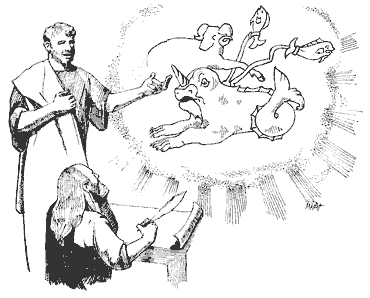 |
An angel reveals the constellations to Enoch.
If the constellation signs truly came from God, they then would be of great importance. But could the constellations really be that old? Didn't they originate with the Greeks? It turns out
there are scientific ways to date the origin of the entire Greek set of star figures. There is a circle in the southern sky in which no ancient constellations are found because that area always stayed below the horizon of their author (See Figure 1). The circle of invisibility slowly moves, so its location can be used to provide a rather precise date of origin. Its position indicates that the constellations predate the ancient Greeks by some 2,000 years.[1] The origin date of about 2900 BC fits Enoch's lifetime perfectly, supporting the Book of Enoch's claim. If it is true they began with Enoch, then the study of the original set of constellations should prove to be marvelous. Indeed, they would be a testimony of God echoing to us from before the Flood.
 |
Figure 1. The 48 ancient constellations. The empty circle implies they originated about 2900 BC.
Much groundwork has been done in explaining how the constellations testify of Christ and of the
entire plan of salvation. The original modern work was done by Frances Rolleston about 1860.
She did a massive amount of research, and her work has recently been republished.[2] Both Joseph Seiss and E.W. Bullinger added to and refined some details of her work.[3] Today there are a number of Christian books which summarize this entire approach and I have posted on my website a brief summary of the work, along with a response to common objections.[4]
In former articles, I have introduced the concept that the constellations are inspired.[5] In fact, it was
mentioned in the very first issue of Meridian Magazine as something that everyone should know about astronomy.[6] I have written articles on the four "cornerstone" constellations,[7] interpreted the twelve zodiac constellations and deduced their colors,[8] attempted to restore the "lost" constellation,[9] and even shown
how the timing of Christ's resurrection was prefigured therein.[10] But I have never summarized the entire set of constellations because it was not clear which constellations were included in the original set. This article introduces my proposal for the entire set and suggests religious meanings for each.
1. Which are Enoch's Constellations?
Hebrew tradition is that the set of constellations was first revealed to Enoch and perhaps even
earlier antediluvian prophets.[11] Noah preserved them through the Great Deluge, and
they were transmitted to Egypt by Abraham (Abr. 1:31, 3:15). The Greek scientist Eudoxus received a detailed map of them about 400 BC on a celestial sphere from Egypt. His description has been preserved by Aratus about 270 BC in his poem "Phaenomena."[12] We also have the star catalog of Ptolemy, a Greek
astronomer of about AD 150, which lists where each star is in the figure.[13] Most ancient astronomers carefully followed tradition about
exactly where to place every star because they believed that the "gods" had drawn the figures.
There was apparently a tradition that there were 48 constellations in the original set. Ptolemy listed
48, and the Persians a few hundred years later also list 48. They agree that there were
twelve in the region of sky where the sun and planets all appear to move. Those twelve are called
the zodiac, and the Egyptians and Persians both understood that each had three associated
constellations called "decans," bringing the total to 48. Whereas little work has been done on
understanding the Egyptian set, we have a list of all 48 constellations from the Persians, including
how they are divided into decans. Rolleston's great contribution was to discover this set and to
recognize their meaning from a Christian perspective.
 |
Did Daniel preserve Enoch's constellations?
So which list, if any, provides us the "true" original set? All of these sources virtually agree on 45
of the 48. Apparently some had been lost and the Greeks invented some to take their place.[14] The first draft of this article was going to justify yet another
proposal, but after finalizing the research, it now appears that the Persians did indeed have the
correct ancient list.[15]
That is astounding to me, and causes me the conclude that it might well have been Daniel who
restored the correct list when he presided there with Cyrus around 550 BC. So without further
justification, I will use the same list of 48, as summarized by Albumazar about AD 850,[16] which is exactly the list chosen by Rolleston and hence used in all of the work done so far on this subject.
2. Twelve Gospel Chapters
Let us now briefly review how the constellations testify of the gospel of Jesus Christ. The
proposed interpretation is not totally clear, but there are enough references to the same symbols
used throughout the scriptures that there is little doubt that the general idea of Rolleston's
claim is true.
Before beginning, it is important to understand that it is context which gives any symbols their
meaning. When a phrase is taken out of context, it can then be given an entirely different meaning.
This is commonly done in fields as wide ranging as interpreting scripture to interpreting the law.
Even the alphabet characters with which this article is written only have meaning when taken in the
context of the English language. Thus, the meaning of the symbols of the constellations discussed
in this article refer to the context of the life, mission and gospel of Jesus Christ. In another context,
they could (and do) have an entirely different meaning.
The zodiac circle has a natural beginning with the constellation of the Maiden (Virgo) and ending
with the Lion (Leo).[17] The Virgin also is a logical beginning place for the gospel story, which
the virgin birth of Jesus Christ. But again the reader must be cautioned that in other contexts, this
Maiden could have other meanings.[18] In this context, the order of constellations is roughly a time line, beginning with the birth of Christ and continuing through the deeds of the First Coming, his interaction with mankind and his Church, and then of the Second Coming and Christ's reign during the Millennium.
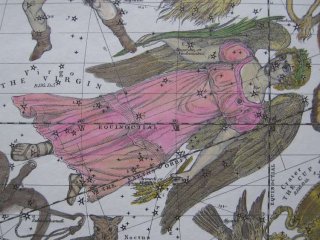 |
The Maiden.
2.1 The Maiden
The story of Jesus Christ on earth can be said to begin with a virgin, and the first constellation of
the zodiac is the Virgin or Maiden (Virgo). In the sky, this huge constellation only contains one
bright star. It is Spica, the Grain of Wheat which she holds in her hand. Isn't it interesting
that the star was not placed in a prominent position in the woman herself, but rather in something
she holds? She is also usually shown holding a palm branch in her other hand. The proposed way
this sky mural works is that each of the three decans will help explain something more about just
who this woman is.
 |
The Infant Prince Horus from the Planisphere at Dendera.
The first decan in the constellation of the Infant Prince (in the area of both Coma Berenices and Canes Venatici). This is one constellation which was lost to the Greeks, but was preserved by the
Persians, who described it as an immaculate virgin sitting on a throne and holding an infant.
Rolleston identified the general area of the sky where it was located and in an earlier paper I attempted to identify the seven stars which it comprised.[19] Thus, if the purpose of
this constellation is to explain more about the Maiden, then it would show that the virgin was really
a queen and that her seed (of wheat) really represents her child. If her child were more important
than she, that would explain why the seed is the brightest star in the Maiden. The brightest star in this decan (Cor Caroli) is also located in the child rather than the mother.
 |
The Centaur slaying the Beast.
The second decan is the Centaur (Centaurus), which, being half horse and half man, might well
symbolize that fact the woman's child would genetically be half god and half mortal. The Greeks
called this centaur Chiron, who was immortal, being the son of Chronos, but who was then made
mortal so that he could be allowed to suffer death to relieve him from the agony caused by having
been shot with an arrow dipped in the blood of the monster Hydra.[20]
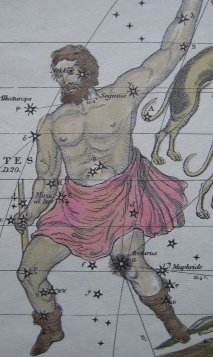 |
The Herdsman.
The third decan is the Herdsman (Bootes), who was called "The Righteous Shepherd"
anciently.[21] In this context, he should probably be called "The Good Shepherd" who was the
man that the infant prince would grow to be. The Savior identified himself as most of these
constellations which represented him. For example, he not only said he was the Good Shepherd
(John 10:11), but also the "grain of wheat" which must die in the ground in
order to bring forth much fruit out of the ground (John 12:24).
Combining these four concepts indicates that this constellation is like a summary of various aspects
of the Savior's life. As discussed in detail in the earlier article focusing only on the twelve
constellations of the zodiac, the proposed title of the Savior is this group is the Messiah.
In an earlier article a color was deduced for each of the zodiac constellations.[22] Figure 1 shows all 48 constellations color coded so that the three decans match the colors of the associated zodiac constellation. For example, the Maiden, Infant, Centaur and Herdsman are all shown in light blue. The purpose of coloring them in that manner is to show how the decans are grouped in the same direction from the centers of the northern and southern circles (the ecliptic poles). Note that all of the zodiac constellations are cut in half between the two hemispheres.
 |
The Balance.
2.2 The Balance
The second zodiac constellation is the Balance or Scales (Libra), which were used before coins
for weighing out money for payment. The meaning seems to be that Christ would "pay the price"
in order to redeem mankind. Indeed, Christians have been "bought with a price" (I Cor 6:20, 7:23). The corresponding title of the Savior is the Redeemer.
 |
The Cross.
The first decan is the Cross, also called the Southern Cross (Crux). This is another constellation
which was lost to the Greeks, and counted as part of the stars of the Centaur. The Persians included
it as a separate constellation, as a man holding a balance in one hand and a lamb in the other.[23] It appears that the Lamb is being used to pay the price demanded by Justice.
The second decan is called the Beast (Lupus), shown above with the Centaur. The type of animal it was is not clear, and it is
often called the Wolf. According to the Greek myth, it was about to be slain by the Centaur to be
placed on the Altar (Ara).[24] That could well represent that Christ would be slain as a sacrifice, to pay the price of sin.
 |
The Crown.
The third decan is the Crown, or Northern Crown (Corona Borealis). This beautiful little
constellation which is indeed a ring of stars, seems clearly to represent the crown in heaven which
is the reward for having paid the price. In the stars, it is the crown being eyed by the Serpent,
indeed, for which the Serpent is apparently reaching.
 |
The Scorpion, Healer, Serpent and Crown.
2.3 The Scorpion
The third zodiac constellation is the Scorpion (Scorpius). In the context of the life of Christ, this
constellation represents the enemy Death. This meaning is indicated by the three accompanying
decans.
The first decan is the Serpent (Serpens), which is wrapped around a man. Because in the sky the head is on one side of the man and the tail on the other, it is often considered as two constellations, the
Serpent's head (Serpens Caput) and the Serpent's Tail (Serpents Cauda). This constellation tells
us that the snake is another symbol of the scorpion.
The second decan is the Serpent Bearer, or Healer (Ophiuchus). He is the man wrestling the Serpent. Moreover, he is standing on the head of the Scorpion and his other heel is apparently
being stung by the scorpion. These vivid symbols recall the great promise given to Eve, that
someday her seed (descendant) would crush the serpent's head, even though the serpent would
bruise his heel (Gen. 3:15). That scripture clearly refers to the fact that Satan would have the power to
torture the Savior, but that eventually Christ would overcome and crush Satan and even Death itself
with the resurrection. "Oh death, where is thy sting?" (1 Cor. 15:55, Isa. 25:8, Mosiah 16:7-8,
Alma 22:14, Mormon 7:5).
 |
The Caduceus.
Most of the English translations of constellation names given in this article agree with astronomy books, which generally call this constellation the Serpent Bearer. Here I introduce a new
name for this constellation, the Healer, for two reasons. First, a shorter name is sometimes
needed, and second, that is the deeper meaning of the constellation. It is not only death, but all
disease which is overcome, and indeed, Jesus was the master physician. He gave his disciples the
"power to tread on serpents and scorpions" (Luke 10:19). The constellation reminds us of the
caduceus, which is the serpent entwined around the pole, the symbol of medical doctors to this
day. In the Greek myths, this constellation represented Asclepius, the god of medicine, who was
so skilled that he could even raise the dead.[25]
 |
Hercules.
The third decan is Hercules. At first the Greeks did not recognize who this man was, and called
him only "The Kneeler." He is kneeling on one foot, while his other foot rests squarely on the
head of the Dragon. Later Eratosthenes identified him as Hercules, who triumphed over the
dragon,[26] and that interpretation is probably correct. In any case, here we again see a repetition of the
head of a serpent being crushed, and by comparison to the Healer, we can perhaps conclude that
the other heel has been wounded. Hercules was a son of the god Zeus and a mortal woman and
who became immortal. He had twelve great labors to perform, and in an earlier article the twelve
great labors of Jesus Christ were summarized.[27] These four constellations are thus all closely
tied to the theme of one who overcomes dragons, serpents, and scorpions.
There are two titles of the Savior which could be associated with this group. The principal title is
the Judge, referring to the Scorpion who is the messenger of judgment to the wicked. But another
title associated with the Serpent Bearer or Healer is that very concept, the Healer or Master
Physician.
 |
The Archer.
2.4 The Archer
The fourth zodiac constellation is the Archer (Sagittarius), a centaur who was depicted with wings in the ancient Egyptian zodiacs. The Greeks showed him with a great cape flowing from his back, but to me it appears that they could not recognize what the wings were. In any case, the Archer is
apparently shooting at the Scorpion. The associated role of Jesus Christ is that of the Savior.
 |
The Harp.
The first decan is the Harp or Lyre (Lyra). It is the small, hand-held type of harp, and is usually
depicted as made of a tortoise shell (by Hermes in the Greek myth) or sometimes in the shape of an
Eagle. The harp has long been associated with angels and angelic music, probably because it has
seen in vision as being held by angels (Rev. 5:8, 14:2), especially by the seven angels after having
gotten victory over the beast and his image and his mark (Rev. 15:2). This gives us a clue that the
archer is a symbol of the rejoicing after the victory over Satan and Death.
 |
The Altar.
The second decan is the Altar (Ara). In this context it is apparently the altar of sacrifice on which
the Savior was slain, as described above.
 |
The Dragon.
The third decan is the Dragon (Draco). It is found at the very top of the sky (the ecliptic pole, the center of the upper circle in Figure 1). In this
context, it represents Satan who wanted to exhalt himself to the top of the heavens (Isa. 14:12-13).
He is coiled in such a way that the folds of his tail open up such that they could be said to hold
about one third of the stars of heaven. Accordingly, this was most likely the great red dragon sign
(constellation) seen in the heavens seen by John (Rev. 12:3-4). Again, this is the dragon whose
head is found under the foot of Hercules. Thus, these three constellations fit nicely with the theme
of Satan having been overcome.
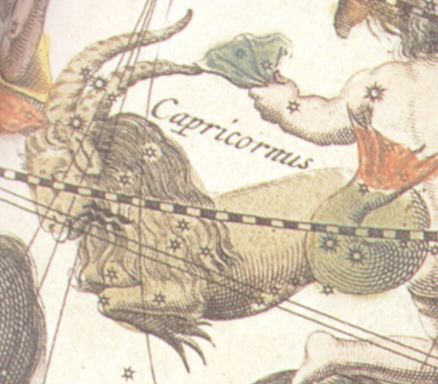 |
The Sea-Goat.
2.5 The Sea-Goat
The fifth zodiac constellation is strange indeed. The top half is a goat, and the bottom half is the
tail of a fish. Hence it is called the Sea-Goat (Capricornus). It is wounded and on one knee, and
some of the ancient star names indicated that it is a sacrifice.[28] The goat was one of the sacrificial
animals in the law of Moses, especially the scapegoat that took upon itself the sins of Israel to atone for
them on the Day of Atonement (Lev. 16:10). The corresponding role of Jesus Christ is that of the Great Sacrifice.
 |
The Arrow.
The first decan is the Arrow (Sagitta). It is not well understood. Eratosthenes said it was a silver
arrow of Apollo. In this context it would be the arrow with which the Sea-Goat was slain as a
sacrifice.
 |
The Eagle.
The second decan is the Eagle (Aquila). In this context it would probably be a wounded eagle,
which is what Rolleston and all who have followed her have proposed. Such is not clear at all
from the figure, but may well be correct. The Eagle and the Arrow might also represent Christ as a messenger from the Father.
 |
The Dolphin.
The third decan is the Dolphin (Delphinus). This decan would indicate that the tail of the Sea-Goat is that of a dolphin. It is shown jumping out of the water, and very
much alive. Anciently, the dolphin was a symbol of life and resurrection.
Thus, putting the four all together suggests that two halves of the Sea-Goat represent that the
sacrificial goat would die for the sins of Israel, but would then resurrect.
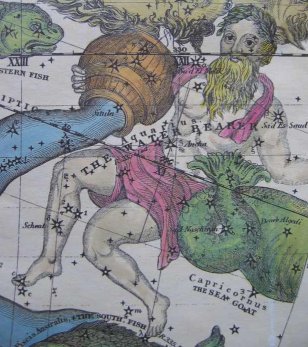 |
The Waterman.
2.6 The Waterman
The sixth zodiac constellation is the Waterman or Water Bearer (Aquarius). He is a man who
pours an entire river of water out of a jar, which flows onto the head of a fish. As discussed in my
previous articles, this figure represents Christ as the Master Teacher and Lawgiver, who pours out
blessings on the heads of his people, or church.
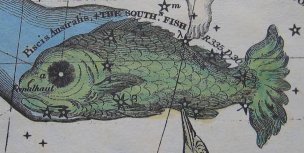 |
The Southern Fish.
The first decan is the Southern Fish (Piscis Austrinus). It is simply a large fish, which receives
the water poured out by the Waterman. Sometimes the water is shown entering the mouth of the
fish. The fish is a symbol of Christianity, or at least of the Lord's followers, even as the Lord called his "fishers of men." Thus, the water being poured onto the fish appears to
represent blessings and knowledge being poured out on the heads of the followers of Christ.
 |
The Flying Horse.
The second decan is the Flying Horse (Pegasus). The myths about Pegasus are all about things
which happen very late in the story. He tends to come flying back carrying a hero to victory in the wrapping up scenes. Thus, he seems to be tied to events surrounding the Second Coming. That matches the scriptural symbolism perfectly, that the Savior will return from heaven riding a white horse (Rev. 19:11).
 |
The Swan.
The third decan is the Swan (Cygnus). The Greek myths are not much help here; there are many
variations, but most agree that the Swan represented Zeus in disguise. The Christian interpreters
have mostly associated the Swan with the swift return of the Savior (the one who blesses) at the
Second Coming. Thus both the Swan and the Flying Horse are seen as variations on the same
theme.
 |
The Fishes, Bands, Ram and Sea Monster.
2.7 The Fishes
The seventh zodiac constellation is the Fishes (Pisces). The mythology is that Venus and Cupid
jumped into the river to escape a monster and were saved by being changed into fishes. As
mentioned above, the fish is a symbol of the Christian Church. The mythology is not far from
being saved by being turned into Christians when baptized in water. So the two Fishes seem to
represent two different groups of followers of Christ. The role of Christ symbolized by the Fishes
would be that of being the Great High Priest (Heb. 4:14).
But what two groups? The Christian commentators tend to agree that the two are probably the
church before Christ and the Church afterward, referring to the patriarchal church of Israel led by
Moses, and then to the Christians headed by Christ.[29]
The first decan is the Bands (part of Pisces). The two Fishes are tied by their tails with Bands to the great Sea Monster (Cetus). Moreover, the leg of the Ram (Aries) is apparently breaking the Bands. That feature is not mentioned in Greek myth, but it is important to understanding the symbolism. A common theme in the scriptures is that Christ will break the
bands of death. Here we apparently have a perfect figure of this prophecy. The Ram, which
is an adult male Lamb, is seen breaking the bands which tie the two groups of the followers of
Christ to the monster. Thus, the monster could well represent Death, the Ram being Jesus Christ,
and the Bands are the bands of death.
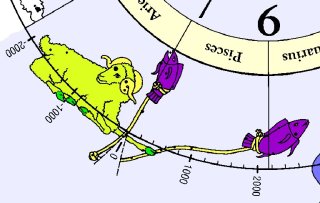 |
Figure 2. Two Fishes (Churches) at two times.
So what do the two fish each represent? When the Savior resurrected, many of the righteous saints
did also. One of the slowly moving hands on the great celestial clock is the vernal equinox, the
position of the sun in the sky on the first day of spring. It moves one degree every 72 years, and thus can be used to indicate dates. The numbers on the scale in Figure 2 are the years indicated by that "clock hand." It crossed the star which is the knot in the tail of the fish
nearest the Ram precisely on Sun 3 Apr AD 33, the most likely day of the Savior's
resurrection.[30] Thus, not only is the symbolism of breaking the bands of death portrayed vividly in the heavens, even the date is indicated. If the size of the fish also refers to this timeline then the first fish represents the early church of Jesus Christ, which lasted until about AD 300.
What about the second fish? Figure 2 shows that the equinox crosses the first and last star in the second fish about the years 1800 and 2800. If this reasoning is correct, then the second fish could represent the saints of a latter-day church of Jesus Christ.
 |
The King.
The second decan is the King (Cepheus). This meaning is less clear, but seems to represent the
enthronement of Christ as King. He is often pictured holding ribbons, which could correspond to the broken bands of the fishes.
 |
The Chained Princess.
The third decan is the Chained Princess (Andromeda). The other common symbol of the
church of Christ is the woman or bride, whereas Christ is the bridegroom who marries the church.
This princess is chained to a cliff and is being offered as a sacrifice to the very same Sea Monster
to whom the Fishes are bound. So here we have another figure representing the church being bound.
But there could be slight difference in interpretation. The scriptures speak of "the bands of death,
and the chains of hell" as distinct from each other (Alma 5:7-10; see also 2 Peter 2:4, 2 Nephi 1:13,
28:22; Alma 12:11, 13:30; D&C 121:44, 123:8, 138:23). Note that the scriptures rarely vary from
that imagery of the "bands (or cords) of death" and the "chains of hell." Christ did two
things for us. First, he broke the bands of death, so that someday all of us will resurrect. He also
loosed the chains of hell, so that someday those who follow his commandments can escape
bondage to Satan. Thus, the Fishes and Bands represent breaking the bands of death, whereas the
story of Andromeda represents loosing the chains of hell. This nuance of detail in interpretation
seems to have escaped earlier commentators, but is being proposed here because the symbolism is
so consistent in scripture.
 |
The Ram.
2.8 The Ram
The eighth zodiac constellation is the Ram (Aries). He is depicted as a magnificent Ram, with one
foreleg extended between the Bands. His other foot in on the head of the great Sea Monster. The
Greek myths describe him as the Ram with the golden fleece, which was the object of the journey
of all the argonauts on the great journey led by Jason. That journey is also shown in the sky in the
constellation of the Ship.
The clear symbolism of the Ram breaking the Bands of Death suggests that the Ram represents the
role of Christ as the Resurrection. He said "I am the Resurrection" (John 11:25). The golden
fleece may represent the brilliant, golden aura one has when resurrected with the highest glory,
which can shine brighter than the sun.
 |
The Queen.
The first decan is the Queen (Cassiopeia). If the princess represents the Christian church, then the enthroned queen could represent the final glory to which the church can attain. Such an
interpretation indeed follows the theme proposed for the Ram, and would indeed be an excellent
object for a quest of many great heroes.
 |
The Sea Monster.
The second decan is the Sea Monster (Cetus). He is both the monster to whom the Bands of
Death are attached, and also the monster who was to devour the Chained Princess. That would
indicate that he represents both death and hell. Jacob, the brother of Nephi in the Book of Mormon,
explains that dual imagery: "O how great the goodness of our God, who prepareth a way for our
escape from the grasp of this awful monster; yea, that monster, death and hell, which I call the
death of the body, and also the death of the spirit" (2 Nephi 9:10).
 |
The Hero.
The third decan is the Hero or Bridegroom (Perseus). Even as the Ram breaks the bands of
death, it is the Hero Perseus who loosed the chains of hell from the Chained Princess.
In the myth, he sees her about to be devoured as he is returning from having slain the Medusa. Before he saves her, he extracts a promise from the onlooking parents (King and Queen) that if he saves her he can marry her. They agree and he slays the monster with his sword. He then marries the Princess.
The returning Hero again matches the scriptural symbolism of the Savior who returns on a white horse from heaven and wields a sharp sword (Rev. 19:11-16). He is the hero who saves and then marries the church. Thus another title for Jesus Christ associated with this group is that of the
Bridegroom. Indeed, Aratus used that very concept as a synonym for Perseus.[31]
 |
The Bull.
2.9 The Bull
The ninth zodiac constellation is the Bull (Taurus). He is a great white bull of the variety of wild
ox which has two long forward-pointing golden horns. His forelegs suggest that he is charging
forward. On the other hand, he has seven doves on his back (the Seven Sisters), and some have
suggested that the bent legs indicate that he is peacefully reclining. Here it is not the Greek myths, but
the Book of Enoch which makes it clear what the white bull represents. It is the millennial
Kingdom of God which will soon govern the earth for a thousand years, after the destruction of
the wicked. In the context of the works of Jesus Christ, the Bull represent him as the Lord of Hosts, the leader of the hosts of the armies of Israel, who will vanquish opponents and rule in peace.
 |
The Hunter.
The first decan is the Hunter (Orion). The is the brightest and most glorious constellation of all.
In the Greek myths he is always a Hunter. He looks a lot like Hercules in
that he is shown holding a club in one hand, a lion skin in the other, and wears a pearl belt, but
the Greeks never confused him with Hercules. In this context, it must represent Christ, the King of Kings who will reign during the Millennium. Most Christian commentators identify him as Christ during his millennial reign.
 |
The River.
The second decan is the River (Eridanus). It is a river which begins at the knee of the Hunter and
proceeds down and was supposed to encircle the southern ecliptic pole, much as the Dragon is
coiled about the north ecliptic pole. In the mythology, this is the river into which Phaethon was
cast and his body burned after he failed to control the chariot of the sun. The Christian interpreters
have associated it with the river of fire mentioned in Daniel, which issued forth in front of the
Ancient of Days: "A fiery stream issued and came forth before him" (Dan. 7:10). While it certainly
appears to be some sort of River of Judgment, it was not considered a River of Fire by the
ancients. For example, Jason and the Argonauts navigated it. Nevertheless, the association of this
River with that of the Ancient of Days makes sense in interpreting it as explaining more about the
Bull. That is, if the Bull is the Millennial Kingdom of God, then the Hunter could be the Ancient
of Days who will come and the River the judgment of the wicked. Moreover, the entire myth of
Phaethon losing control of the sun's path in the heavens, and starting the earth on fire sounds a lot
like the prophecies of the earth reeling to and for like a drunken man, and the earth burning before
the Second Coming. All of these events tie to the beginning of the Millennium.
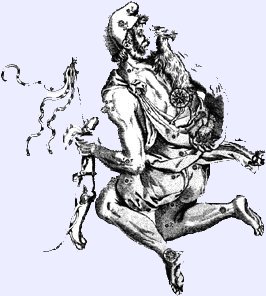 |
The Charioteer.
The third decan is the Charioteer (Auriga). He is depicted as man holding chariot reins in one
hand and a goat with her two kids in the other. The Greeks had three interpretations of possible
charioteers, none of which referred to Phaethon. The Christian interpreters believe that it is not a
charioteer at all, but rather another depiction of the herdsman, indicating
that the great King of the Millennium (the Hunter) is the same as the Good Shepherd. But perhaps it really is a charioteer, possibly referring either to John the Baptist, or another like
him, who is a servant of God who will help prepare the way for the Second Coming. This
constellation requires more research.
 |
The Twins.
2.10 The Twins
The tenth zodiac constellation is the Twins (Gemini), who are two brothers, with one usually
being considered immortal and the other mortal. The mythology is really fuzzy on these two, and
there is little agreement as to who they really are. Sometimes one is shown with a club to identify
him as Hercules and the other with a harp and bow and arrow to indicate Apollo, but Aratus did
not mention any such instruments. The Christian interpreters have
suggested that it represents God the Father and his son Jesus Christ being
identical in looks. To me another possible meaning in this context is that the Immortal One who comes at the Second Coming is the same as the mortal Son of Man who came at the First Coming. That
interpretation is supported by the decans. Referring to the first proposed meaning, the associated
title of Jesus Christ would be the Son of God.
 |
The Hare.
The first decan is the Hare (Lepus). It is shown under the foot of Orion, as if being crushed even
as the various other dragons, serpents, and scorpions. Thus, it is identified with evil and with the
enemy. The Persians showed it as a serpent, and the Egyptians showed Orion (Osiris) standing on
a serpent with a bird on the serpent's back. But to the Greeks, this was the Hare which the Hunter
is pursuing. The Christian interpreters identify it only with "the wicked" who will be destroyed at
the Second Coming, but to me the meaning is much more precise.
Why was a hare chosen as the enemy? That doesn't sound very ferocious, like a dragon or
venomous serpent. Was is not because of the promiscuity of that animal? The Book of Revelation
makes it clear that there are two distinct enemies in the last days. One is the great harlot "Babylon"
who controls the kings by riding on the back of the beast, the other enemy (Rev. 17:3-6). The beast
seems to represent the governments of the wicked (enslaving) nations, whereas the harlot is probably the secret combinations of those behind the scenes who control many nations. The kings hate to be
controlled, knowing they are merely being used by the harlot, so they hate her and eventually kill her
(Rev. 17:16). Thus, whereas the Hero and the other dragon-slayers seem to focus more on killing the
beast, the Hunter is focused on slaying the controlling force behind it. I believe
the Hare to be the original figure, but the Egyptians and Persians, understanding the meaning, replaced
it with the serpent, or better, with another animal riding the back of the serpent.
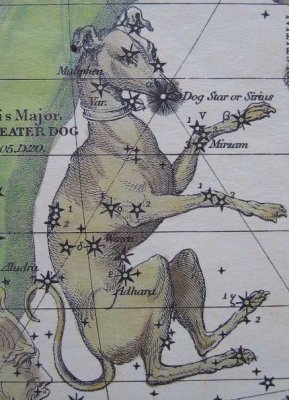 |
The Big Dog.
The second decan is the Big Dog (Canis Major). It is usually depicted as a greyhound, because it is
the dog of the Hunter who is chasing the Hare. In this context, both the Hunter and the Big Dog represent Christ, hunting down the Hare. Again the decans help show just what the Hunter is pursuing, in case the myth is not known.
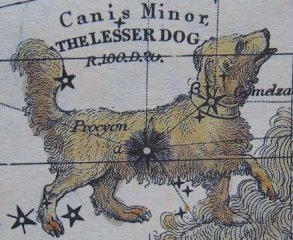 |
The Little Dog.
The third decan is the Little Dog (Canis Minor). Whereas there is no question that the Big Dog belongs to the Hunter and is pursuing the Hare, the mythology of the Little Dog is less clear. Some say
it is another dog of the Hunter, whereas others provide a separate myth for it. In our context,
however, both the Big and Little Dog are to explain more about who the Twins
are. Are not the Big and Little Dog the same as the two Twins, indicating that one twin is the
Little Dog who represents the Savior at the First Coming (in meekness), whereas the Big Dog (a
brilliant constellation) is the Savior at the Second Coming, when he comes in power to destroy the enemy? The two dogs correlate well to the two twins.
 |
The Crab.
2.11 The Crab
The eleventh zodiac constellation is the Crab. The symbolism in this context seems clearly to
represent the role of Jesus Christ as the Deliverer. Sometimes in Egypt the same constellation and concept was shown by the scarab beetle, which rolls a dung ball along. The crab can pick up
things in its powerful right hand and deliver them to the desired destination. The Great
Deliverer descended into hell and the gates of hell could not prevent him from delivering his people
to freedom from the bondage of death and hell. This deliverance has not only happened in the past,
it will yet happen in the future just before the beginning of the millennial reign of Christ, when the
righteous will again be delivered from the grasp of the seven-headed dragon kingdom which is
about to enslave as much of the entire world as it can and persecute Christians as never before.
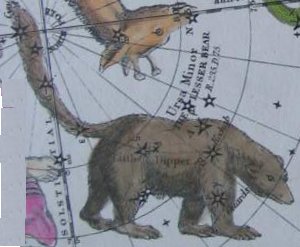 |
The Little Bear.
The first decan is the Little Bear (Ursa Minor). This constellation is shown merely as a small bear with a very large tail. In the Arab world it was a small flock, and to the Persians it was a woman. The meaning of all three seems to refer to a group of faithful followers or saints. Both the flock and the woman are more common symbols for that meaning, but from what I can tell, the bear is the original constellation and the others were changed to make it easier to understand.
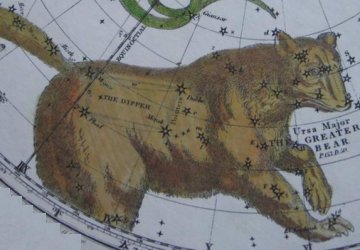 |
The Big Bear.
The second decan is the Big Bear (Ursa Major). Like the Little Bear, this constellation is also depicted as a bear with a very large tail. In the Arab world it too was a small flock, and to the Persians it was also a woman, and all with the same symbolism as the Little Bear. Both of these bears or flocks were guarded in the myths by the Herdsman, who is nearby.
 |
The Ship.
The third decan is the Ship (Argo). This was a huge constellation in the southern sky and has since been divided into several constellations by modern astronomers. The Greek mythology is that Jason led the expedition of the Argonauts on a quest to get the golden fleece of the Ram. He had some illustrious passengers aboard including Hercules. They finally succeeded in their quest. In the Persian tradition, this constellation also is a woman, and the three decans are considered a group of three women.
So what do all of these decans have in common, and how do they help explain the meaning of the crab? To me, they all represent different groups of saints who were or will be delivered by the great Deliverer. The ship is most likely referring to travelling in the underworld. That is, Jason is leading spirits of dead heroes on a quest for resurrection (represented by the golden fleece) and eternal life. Similarly, the Herdsman is leading the bears or flocks to a similar goal. Each group probably has a specific meaning, but so far the precise meanings have eluded me. But we know that at the beginning of the millennium, many righteous will be resurrected (Rev. 20:4), so their quest for the golden fleece for many will be fulfilled at that time.
 |
The Lion.
2.12 The Lion
The twelfth and last zodiac constellation is the Lion (Leo). He is a magnificent Lion which is pouncing on the head of the fleeing giant Water Serpent. In the Egypian planisphere he his shown actually standing on the serpent. So once again a hero is attacking a serpent, and apparently focusing on crushing its head. Part of the mythology is that the Lion was placed in the heavens because he is the king of beasts.
The religious symbolism of the lion is similar. Christ is referred to as the "Lion of the tribe of Judah" (Rev. 5:5), and the lion seems to refer to Jesus Christ in his role as King. This constellation most likely refers to Christ as King of Kings, reigning all during the coming Millennium, after he has destroyed the horrible beast.
 |
The Water Serpent.
The first decan is the giant Water Serpent (Hydra). This is a very long constellation which wraps nearly a third of the way around the heavens. Anciently it was near the celestial equator, and gave rise to the mnemonic that the dragon swallows the sun during an eclipse. The Greek mythology is that Hercules had to fight the Hydra, and when he cut off one of its many heads, it grew two new heads in its place. It is clearly one of the great forces of evil, similar to the Sea Monster. The Sea Monster represents death and hell, which were overcome at the First Coming, but the beast of evil government was not overcome at that time. The Water Serpent apparently corresponds to that monster which comes out of the sea to persecute the saints (Rev. 13:1). It is only overcome at the Second Coming of Jesus Christ.
 |
The Cup.
The second decan is the Cup (Crater). It is apparently attached to the back of the serpent. It does not have much mythology nor clear symbolism in the scriptures. The Christian commentators have noticed that it might represent the cup of the wine of the wrath of God, to be poured out on the harlot (Rev. 16:9). It occurs to me that it might also represent the golden cup held by the harlot who rides the beast (Rev. 17:4). By using the figure of a cup, both the harlot herself and her punishment can be represented.
 |
The Raven.
The third decan is the Raven (Corvus). It is also on the back of the Serpent and Aratus stated that it looked like it was pecking at the snakes coils.[32] That is reminiscent of the Lord's invitation to the fowls of heaven to devour the body of the slain beast, that is, the flesh of the armies of the wicked nations who fought against God (Rev. 19:17-18).
3. Conclusion
It appears that all 48 of the original constellations can be identified and that they indeed form a more or less coherent representation of the gospel of Jesus Christ. There is still much more research to be done, especially to fill in details, but the general outline seems clear. A virgin Maiden is the mother of an Infant Prince who is half mortal and half god (Centaur) and who will grow up to be the Good Shepherd (Herdsman). He is the Redeemer who will pay the price of sin (Balance) through his suffering (Cross) as a sacrifice (Beast) in order to win the Crown. He will be the great Healer who will crush sickness and death (Scorpion). He is the Savior (Archer, Hercules) who slays the Dragon, resulting in great rejoicing (Harp). He is also the Goat (Sea-Goat) sacrificed on the Altar, but then resurrecting (Dolphin). He is the messenger of his Father (Eagle and Arrow). He is the Master Teacher (Waterman), who pours out knowledge and blessings on his church (Southern Fish), carrying it upward (Flying Horse) to someday be glorified (Swan). He is the Ram who breaks the Bands of Death, and the Hero who looses the chains of hell which bind and shackle both his former-day and latter-day Church (Fishes) to the awful Sea Monster. The Hero is also the Bridegroom who then marries his Church (Princess). He is enthroned as the King and the glorified church becomes his Queen. At the beginning of the Millennium, Christ reigns as King and Lord of Hosts of the Kingdom of God (Bull). As the royal Hunter he destroys the harlot (Hare) who has perverted religions and governments worldwide, and he executes judgment on the wicked (River). He is both the Father and the Son (Twins). He who comes in power to destroy the great harlot (Hare) at the Second Coming (Big Dog) is also he who came in meekness and allowed himself to be slain by her at the First Coming (Little Dog). He is the Deliverer (Crab) who leads the dead up out of hell (Ship) and delivers his flocks (Big and Little Bears). As the millennial King (Lion), he permanently overcomes the fleeing Water Serpent, who suffers the Cup of the wrath of God, and whose corpse is eaten by birds of prey (Raven).
The fact that so many precise scriptural types of Jesus Christ appear in the constellation figures, grouped by subjects and in chronological order, provides compelling confirmation that the claim of the Book of Enoch is true: The figures were revealed as a testimony of the Elect One who would come to save mankind. It is a visual witness that details of the life of Christ were known long before the Great Deluge. Thus, the constellations form one of only surviving ante-diluvian witnesses of the Good Shepherd, the Redeemer, the Righteous Judge and Great Healer, the Savior, the Ultimate Sacrifice, the Master Teacher, the Great High Priest, the Bridegroom, the Lord of Hosts, the Son of God, the Deliverer, and the King of Kings: Jesus Christ.
Notes
- Pratt, John P., "Scientifically Dating the Constellations," www.johnpratt.com/items/docs/constellations_date.html.
- Rolleston, Frances, Mazzaroth (York Beach, Maine: Weiser Books, 2001), being a reprint of the 1875 edition of that work. The first edition was published by Rivingtons in London in 1862. It is mostly a set of notes and not very readable, even though it is the original source of this theory. But it is required for anyone doing research in this field.
- Seiss, Joseph, Gospel in the Stars (Philadelphia, 1882) and Bullinger, E.W., The Witness of the Stars, (London, 1893). Both of these books are still available as reprints from Kregel (Grand Rapids, Michigan), and are highly recommended as an introduction to the subject.
- One good summary is by Raymond Capt, The Glory of the Stars (Thousand Oaks, CA: Artisan Sales, 1976). Most of these more modern summaries offer little new. My own summary is "Review of Gospel in the Stars" (10 July 2004) at www.johnpratt.com/items/docs/gis/gis_review.html and "Answering Objections to Gospel in the Stars" (10 July 2004) at www.johnpratt.com/items/docs/gis/gis_qa.html.
- Pratt, John P., "Constellations Testify of Christ," Meridian Magazine (9 Oct 2001).
- Pratt, John P., "What Every Mormon Should Know About Astronomy," Meridian Magazine (12 Feb 1999), with the full, longer version published by Meridian Magaine on 12 May 2000.
- Pratt, John P., "The Lion and Unicorn Testify of Christ, Part I: The Cornerstone Constellations," Meridian Magazine (8 Nov 2001).
- Pratt, John P., "The Zodiac Testifies of Christ," Meridian Magazine (15 Jun 2005). The colors were deduced in "Twelve Sons, Twelve Stones," Meridian Magazine (3 Aug 2005), Section 5.1.
- Pratt, John P., "Lost Constellation Testifies of Christ," Meridian Magazine (14 Jul 2004).
- Pratt, John P., "Celestial Witnesses of Christ Breaking the Bands of Death," Meridian Magazine (26 Apr 2001).
- For example, the Jewish historian Jospehus, Antiquities of the Jews I.ii.3. For his exact quote, see my "Constellations Testify of Christ," Meridian Magazine (9 Oct 2001), section 1.7.
- Mair, G.R., Aratus (Cambridge, MA: Harvard U. Press, 1960), pp. 195-299. A more recent translation by Douglas Kidd is Aratus: Phaenomena (Cambridge, MA: Harvard U. Press, 1997). The Mair translation is currently found at www.fillingthesky.com/id82.html. That translation also has links to the public domain pictures from Elijah Burritt's wonderful 1835 star atlas, from which many of the illustrations for this article were taken.
- Ptolemy, The Almagest, translated in Great Books of the Western World (Chicago: Encyclopedia Brittanica, 1952, vol. 16, pp.223-258. It is found in Latin at astro.isi.edu/reference/almagest.html.
- The three on which they differ are the Southern Crown, the Little Horse, and the Triangle.
- Just for the record, my principal concerns were the following. First, there seems to be no ancient evidence for the existence of the Southern Cross as a constellation. Albumazar refers to it about AD 850, but Ptolemy lists those stars as being in the back legs of Centaurus. But when I did a careful study of the 4 x 12 table, there was a hole right in that
location where another constellation was needed. Because the Southern Cross had long since
dropped below the horizon by AD 850 because of the precession of the equinoxes, the Persians
must have had ancient source for their list. Secondly, the Persians divide the constellation of the
Fishes into two, being the Fishes and the Bands. That seemed to me an artificial device to bring
the total to 48. Everyone seems to omit the Seven Sisters from the list just because the
constellation is so small. Aratus described it in detail and I carefully considered recombining the
Bands and Fishes and counting the Pleiades separately. But that did not work. I also considered
dividing the Twins in two, the Water Bearer from his Stream of Water, the Archer from his Bow,
and even the Charioteer and his Goat, all of which Aratus seems to describe as separate
constellations. The only constellation described by Aratus not included in the Persian list is the
Triangle, and I strongly considered that it might have been a more meaningful figure, such as the
shackles which held Andromeda. None of the above worked, so my entire article on this subject
has now been reduced to this footnote to record that I at least considered some alternatives.
- Albumazar (also spelled Albumazer) was a famous sage that you can read about in most encyclopedias. However, I have not been able to find any English translation of his work describing the 48 constellations, but I have the Latin version (at www.johnpratt.com/items/astronomy/albumazar/index.html) which I hope to have translated into English to post on the internet soon.
- This was perhaps the original meaning of the great statue of the Sphinx of Egypt, which was said by Herodotus to have the head of Virgo on the body of Leo. Note that the origin of this fixed circle in the sky is independent of the motion of the planets. The sun rises at the spring equinox in a different zodiac figure about every 2,000 years, but that effect (precession of the equinoxes) is due to the motion of the earth. Most astronomers take the beginning of the circle to be the location of the sun in the age they live, so the absolute beginning place is not well known.
- For example, in Rev. 12:1, the constellation ("great sign in heaven") refers to the church, which gives birth to the child who is the Kingdom of God.
- Pratt, John P., "Lost Constellation Testifies of Christ," Meridian Magazine (14 Jul 2004).
- Ridpath, Ian, Star Tales (New York: Universe Books, 1988), p. 47. Most of the myths quoted in this article are taken from this excellent source book.
- Allen, Richard H., Star Names: Their Lord and Meaning (New York: Dover, 1963), reprinted from 1899 edition, p. 101: "on the Euphrates it was the Shepherd of the Heavenly Flock".
- Pratt, John P., "Twelve Sons, Twelve Stones," Meridian Magazine (3 Aug 2005), Section 5.1.
- Rolleston, II.18.
- Ridpath, p. 48.
- Ridpath, p. 94-95. Note there is a difference between the double serpent on the Caduceus staff of Mercury (Hermes) and the single serpent on the staff of Asclepius. See drblayney.com/Asclepius.html.
- Ridpath, p. 72.
- Ridpath, p. 73-75, and Pratt, John P., "The Zodiac Testifies of Christ," Meridian Magazine (15 Jun 2005).
- The star name Dabih (Beta Cap) means the "Slaughtered One." See Kunitzsch, Paul and Smart, Tim, Short Guide to Modern Star Names and Their Derivations (Wiesbaden: Harrassowitz, 1986), p. 25. Here it must be stated that Rolleston translated many star
names, assuming they all had been transliterated from Hebrew roots. In most cases they were not and most of her translations are not to be trusted at all. Most who have based their work on hers have blindly trusted her translations which is unfortunate. My work uses only translations from unbiased workers, and this source is the best as far as I know.
- Seiss, p. 83 and Bullinger, p. 96-98.
- Pratt, John P., "Celestial Witnesses of Christ Breaking the Bands of Death," Meridian Magazine (26 Apr 2001).
- Aratus, p. 227.
- Aratus, p. 243.

















































